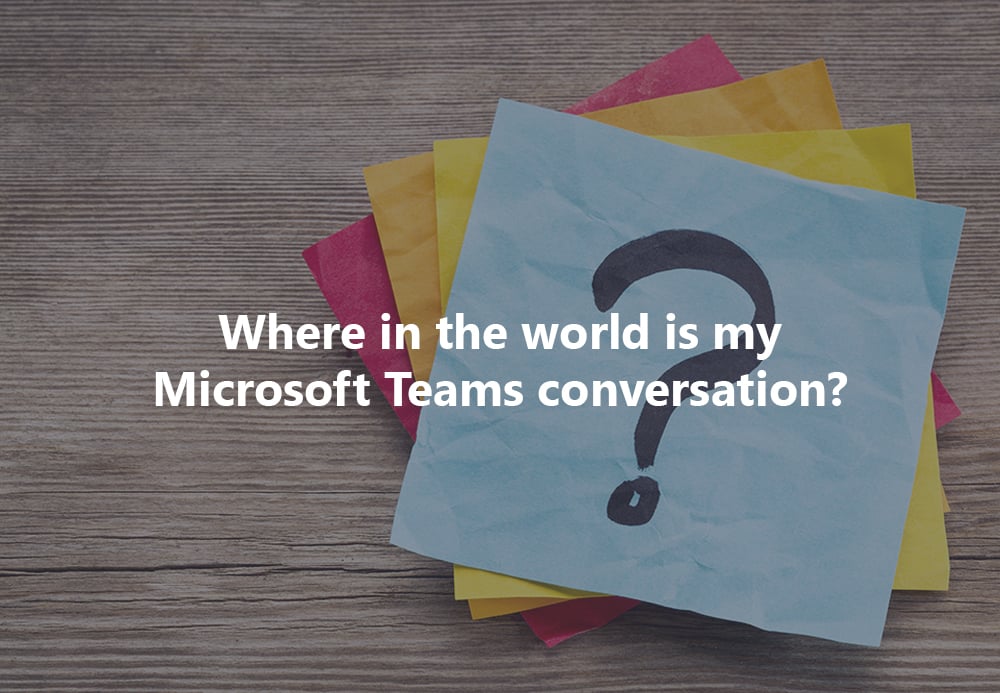Where in the World Is my Teams Conversation?

Loryan Strant

Shared channels are here, and they’re awesome!
At least, that’s what Microsoft says.
The reality is that shared channels in Microsoft Teams pose a number of problems, and to be honest, the platform wasn’t exactly that simple to begin with.
The focus of this piece is not so much shared channels, but really ALL of Microsoft Teams and its various external collaboration methods.
Choose your own adventure
To start with, let’s look at the options available to the average user when communicating with someone from another organisation.
Chat
With chat we already have an endless number of permutations once both users start accessing beyond their own tenants.
- Person A in Tenant A to Person B in Tenant B
- Person A in Tenant A to Person B in Tenant B, attending a meeting hosted by Tenant A
- Person A in Tenant A to Person B in Tenant B, attending a meeting hosted by Tenant B
- Person A in Tenant A to Person B in Tenant B, attending a meeting hosted by Tenant C
- Person A in Tenant A to Person B in Tenant B, as part of a group chat with other people
- Person A in Tenant A to Person B in Tenant B, as part of a group chat with other people
- Person A in Tenant A to Person B in Tenant B, as part of a group chat with other people
- Person A in Tenant A to Person B in Tenant B, as part of a group chat with other people
- Person A in Tenant A to Person B in Tenant B, as part of a group chat with other people
- Person A in Tenant B as a guest, and Person B in Tenant B
- Person A in Tenant A, and Person B in Tenant A as a guest
- Person A in Tenant C as a guest, and Person B in Tenant C as a guest
- Person A in Tenant D as a guest, and Person B in Tenant D as a guest
- Person A in Tenant E as a guest, and Person B in Tenant E as a guest
- Person A in Tenant F as a guest, and Person B in Tenant F as a guest
- Ad infinitum
No, one of the above points was not mistakenly repeated – think about how many group chats you’re in with the same people, both inside and outside of your organisation.
While it may seem unrealistic, it’s a stark reality that in some industries and organisations this may be a reality. Examples would be joint ventures, partnerships, and other relationships where people may find themselves connecting with the same people.
Take me for example:
- I exist in my own tenant
- I am a guest in the Microsoft tenant along with many other Microsoft MVPs
- I am a guest in several vendor tenants that run programs engaging with Microsoft MVPs
What this means, is that I may have conversations with the same people in any number of different configurations. Sure, you could argue that I’m not the average user, however my scenario is not completely out of the realm of reality for end-users.
So, where did I have that conversation about that widget???
Channel conversations
Moving beyond point-to-point and ad-hoc chats, let’s think about more structured scenarios. Before shared channels moved to General Availability, the only structured option was for people to become guests in an external Microsoft Teams tenant.
Let’s look at our permutations of conversation locations shall we?
- Person A in Tenant B as a guest, and Person B in Tenant B
- Person A in Tenant A, and Person B in Tenant A as a guest
- Person A in Tenant C as a guest, and Person B in Tenant C as a guest
- Person A in Tenant D as a guest, and Person B in Tenant D as a guest
- Person A in Tenant E as a guest, and Person B in Tenant E as a guest
- Person A in Tenant F as a guest, and Person B in Tenant F as a guest
- Ad infinitum
While in many cases it is most likely that the invite is in a single direction, the stark reality is that every organisation and group of individuals works a different way.
Take a project as an example. Organisation A creates a Team in their tenant for their project, as it is triggered from a system such as SalesForce or Dynamics, or even just created manually. The intent for this Team is to bring users in from Organisation B so everyone has a central place to communicate and collaborate. Sounds good in theory…
But what if Organisation B has the same intent? This scenario is all too common, because it’s simply not a reasonable expectation that every user involved from the project in Organisation B will join the Team in the Organisation A’s tenant. Even if they did initially, it would very rapidly fall apart as people wouldn’t necessarily remember to tenant switch, people would leave/join the project and need to be added to the Team as guests, and to be blunt – some people just wouldn’t care or see it as a good use of their time (e.g. stakeholders, executives, etc.).
And the reality of tenant switching is that it can’t be done while you’re in a call or meeting without it being dropped, so often users drop the habit very quickly.
Shared channels
Now let’s throw shared channels into the mix, sold as the panacea of the whole guest situation.
A big win of shared channels is that you don’t have to leave your own tenant to participate in channel conversations from another tenant. This is a BIG win. No more accidentally dropped calls/meetings. No more forgetting to switch back and missing things from your home tenant.
Both from an internal and external viewpoint, shared channels is a fantastic solution… if we didn’t already have and use the others.
And shared channels also brings with it one fairly big change in how things work from guest access: guests can’t be added to shared channels.
Take the scenario that you (Person A) are a guest in a Team in Tenant B. Someone in another Team decides to create a shared channel and invites you to that.
How can you access the shared channel in Tenant B? By switching back to Tenant A and accessing it from there.
Got a conversation happening in a non-shared channel in a Team in Tenant B? Switch back as a guest, but now you’ve lost access to the shared channel!
Let’s throw into the mix chat and groups chats with people from Tenant B that exist in Tenant A. I could create a new set of dot points, however the reality would look something like this:

The DaVinci Code
Like the book and its follow-on series, how do we deal with something that was overhyped at the time and seemed like the best thing ever, only to be actually provided with something that is a underwhelming, makes some sense, has you scratching your head at times, is of limited satisfaction, will to continue exist whether you want to participate or not, and can’t be turned into a diamond even if Tom Hanks is selling it?
Well, unfortunately, there’s no one simple answer. And there’s also no way of achieving it without some sort out pain for someone.
Some of the options available and their consequences are:
| OPTION | CONSEQUENCE |
| Disable use of external shared channels | - User frustration. |
| Restrict the use of external shared channels | - IT department frustration at the increased administration burden.. - User frustration when asked questions like “what’s the security group ID you want to use?” |
| Enable the use of external shared channels without restriction or requiring relationship configuration (i.e. open setting) | - Information security nightmare. - User confusion |
| Go through a process of changing guests over to being members of shared channels | - User frustration. - Guest frustration. - IT department frustration at the increased administration burden. Lost of data as not all content can be moved between channels. |
| Disable chat with guests in your tenant | - User frustration. - Guest frustration. - Doesn’t fix the issue in other tenants. |
You could always ensure users are continually well trained and make smarter choices, as well as find ways to manage the various ways of working and communicating.

Ah… that’s hilarious. Who’s going to pay for that?
Adoption and change management unfortunately don’t carry the same level of weight and importance as they once did. Many CFOs think that users don’t need training due to the large array of content available online for free, and the fact that everyone managed perfectly well with the pandemic. I mean, Microsoft Teams usage went through the roof so clearly people have no issues with it.
And who can argue with that logic, right???
X Marks the Spot
Let’s be real, shall we?
You can’t stop progress. People want to collaborate, and the tools will continue to change.
Just because a new feature comes along do you have to use it. Conversely, just because a new way of doing something does the old way have to stick around.
With Skype for Business, Microsoft Teams, Yammer, and other communication methods – organisations haven’t gotten rid of email, and they never will.
However, one thing Microsoft does well is offer choice. Many times, too much choice. In this instance, IT professionals need to look at the nature of how their staff communicate, who they communicate with, what’s realistic, what’s practical, and what options should exist.
Just because the table earlier showed consequences doesn’t mean they shouldn’t be weighed up or actioned.
Right now, users have too many ways to communicate in Microsoft Teams. Help them by guiding them towards the rightest (not a typo) way that works for them.
Do it now, before they go back to sending more emails because it’s simpler to work with.
Microsoft Teams Monitoring
Microsoft Teams has become a mission critical communication tool for companies all around the world. When it is not available, users productivity comes to a screeching halt. Calls flood into the help desk and Microsoft Teams administrators are left wondering is the issue on their side or on Microsoft’s? Hours are wasted on Crit-Sit calls until the root cause is determined.
ENSURE MICROSOFT TEAMS CALL QUALITY
- Assess Call Quality based on Teams CQD metrics over the past month, week and day
- Assess Call Quality for the organization based on feedback directly from your users
- Monitor VIP’s in real time and solve their challenges
- Correlate what is causing poor call Quality
- Provide access to Service Desk and Teams personnel to quickly troubleshoot in real time
Access your free 14-day trial of ENow’s Microsoft Teams Monitoring and Reporting today!

Loryan Strant
Over 20 years in IT Loryan has had the opportunity to work with many leading edge technologies - allowing him to be a part of major transformations in the industry. Starting out in web design prior to the dot com era, Loryan then took on more technical roles and has been involved in some of the first Australian deployments of metropolitan networks, voice over IP and video streaming over the Internet. His technical experiences were followed by 15 solid years in various senior consulting positions advising both internal and external senior management / stakeholders on strategic technology adoption and selection along with delivery of solutions across a range of business sectors, and managing technical resources for delivery. Many of his roles have involved coaching and mentoring team members along with establishing incentive schemes to drive results and growth. One of his strengths is the ability to thoroughly understand each client’s challenges and deliver solution in line with their unique business requirements. Loryan is passionate about the cloud and the opportunities it brings. Having spent most of his career delivering on-premise business productivity technology, he founded Paradyne to deliver cost-effective solutions and to advance how people work by means of the cloud. His deep technical expertise is backed by practical business experience, ensuring that customers get the best of both worlds – world-class technology that delivers real business benefits.
Related Posts


Top Ten Mistakes of Microsoft Teams Administrators - PART 1

Loryan Strant
Putting aside the clickbait-y title (which I created, so lay the blame at my feet), there are a...
